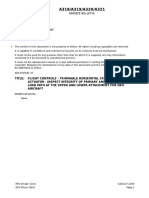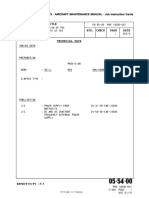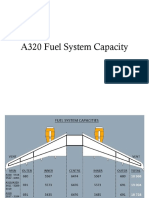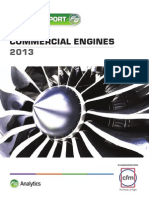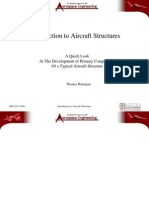Leap Engine
Leap Engine
Uploaded by
vishal kumar sinhaCopyright:
Available Formats
Leap Engine
Leap Engine
Uploaded by
vishal kumar sinhaCopyright
Available Formats
Share this document
Did you find this document useful?
Is this content inappropriate?
Copyright:
Available Formats
Leap Engine
Leap Engine
Uploaded by
vishal kumar sinhaCopyright:
Available Formats
Markets marchs
Other show highlights
Other Safran group companies booked major orders at Farnborough. Aircelle teamed up with Rolls-Royce to sign a 25-year maintenance contract for the nacelles on British Airways Airbus A380s. Messier-Bugatti-Dowty was selected by the Philippine airline Cebu Pacific to supply wheels and carbon brakes for its Airbus A319 and A320 fleet, and will also provide electric brakes to Norwegian Air Shuttle for the carriers Boeing 787s on order.
w John Plueger
President and COO, Air Lease Corporation
Air Lease Corporation
LEAP marks a decisive turning point in aircraft propulsion
Why did you opt for Boeing, with LEAP as the exclusive powerplant? The watchword here is confidence: we trusted CFM Internationals ability to live up to its promises. Theyre one of the worlds leading makers of aircraft engines, with many years of experience, extensive credentials and largely proven products. Furthermore, I believe that the LEAP marks a decisive turning point in aircraft propulsion, since it combines sophisticated technology with energy efficiency and environmental friendliness. What do you expect from CFM International in terms of service quality? We know that CFM International will be able to meet its commitments, including on-time delivery, excellent quality for the price
Eric Drouin / Safran
and of course engine reliability. This also applies to MRO: its dedicated support teams will be able to quickly resolve any problems and limit AOG (aircraft on ground) situations as much as possible in other words, maximize aircraft dispatch reliability while keeping costs under control. How would you describe your relations with CFM International, and how do you think they will evolve? Weve established a solid, sustainable partnership. Over and above this initial order for 75 engines, Im sure that there will be many other shared development opportunities in the years to come.
AVIATION
Farnborough: a giant LEAP forward for Safran
The new LEAP engine garnered an impressive number of orders at the 2012 Farnborough Airshow, reflecting its outstanding performance qualities.
in half and 15 dB less noise. At the same time, it maintains the well-known reliability and low maintenance costs of the CFM56. Airlines want engines that are reliable, fuel-efficient and inexpensive to operate, notes Marc Ventre. And thats what we give them with LEAP. Were also capitalizing on the reputation of the CFM56, and we have retained the basic architecture of this proven engine. Furthermore, we renewed our partnership with GE until 2040 back in 2008, at the same time we launched the new engine, thus reassuring the market that the winning CFM team would still be in place for the next generation.
Market leadership The first selection of this new engine didnt come from one of the legacy plane-makers, but a new entrant, Comac of China. When we first
FM International was in the spotlight at the Farnborough International Airshow in July 2012. The 50/50 joint company of Snecma (Safran) and GE recorded 922 engine orders, including 80% for the new LEAP engine that will replace todays best-selling CFM56. Barely two years after hitting the market, this new engine for nextgeneration single-aisle commercial jets has already logged more than 4,252 orders and options, an exceptional score, enthuses Marc Ventre, Safran Deputy Chief Executive Officer, Operations.
A worthy heir to the CFM56 LEAPs strong point is its impressive performance specs, including a 15% reduction in fuel consumption compared with the latest CFM56 Tech Insertion model, NOx (oxides of nitrogen) emissions cut
20 _ December 2012 _ safran Magazine
4,252 3
orders and options for LEAP engines at October 31, 2012, including 742 orders at Farnborough.
applications for LEAP: Airbus A320neo, Boeing 737 MAX, Comac C919
Entry into service
safran Magazine _ December 2012 _ 21
Boeing
2016
announced the new engine we were in fact ahead of the curve, since no new aircraft was announced at the time, Marc Ventre recalls. But we also understood that airlines were expecting a substantial reduction in fuel consumption before they would make a commitment. Time has proven us right: when Comac launched the C919 in 2009 we were ready. The two world leaders followed: in 2010 Airbus tabbed the LEAP as one of the two engines offered on the A320neo, and in 2010 Boeing chose it as the exclusive powerplant on its new 737 MAX. Orders have poured in since then, along with service contracts. When Snecma and GE renewed their partnership, they extended it to include aftersales service, so they could offer integrated packages, including both the original engine and support services. This proved to be an excellent idea, since 90% of customers choosing the engine have opted for this package. While awaiting the LEAP service entry in 2016, CFMs assembly lines are already running at full speed to handle the large backlog of orders for the CFM56. According to Marc Ventre, Were going to reach an unprecedented rate of about 1,600 engines per year. Our facilities are ready, and we are also making sure that our suppliers can sustain this accelerated pace. At the same time, LEAP development is proceeding on schedule, with the first ground test of a complete engine slated for 2013.
You might also like
- Service Letter Atr72: TITLE: Air Conditioning - General Guidelines For Transporting Dry IceDocument12 pagesService Letter Atr72: TITLE: Air Conditioning - General Guidelines For Transporting Dry IcePradeep K sNo ratings yet
- 00 Cockpit DoorDocument18 pages00 Cockpit DoorKıvanc Terzioglu100% (1)
- Dy CHK - 400 2015 New 737 BOOK NG 00 103Document23 pagesDy CHK - 400 2015 New 737 BOOK NG 00 103Syed Salman UddinNo ratings yet
- 73 13 00 045Document4 pages73 13 00 045jivomirNo ratings yet
- ATA 30 Ice and RainDocument10 pagesATA 30 Ice and RainAlejandroNo ratings yet
- MRB and MPDDocument2 pagesMRB and MPDKelik ArifNo ratings yet
- 9B Motor P&W1100G Ata73-73 ALFADocument76 pages9B Motor P&W1100G Ata73-73 ALFAPiloto TrujillanoNo ratings yet
- B737-3 ATA 52-30 QC L3 REVB New Original PDFDocument33 pagesB737-3 ATA 52-30 QC L3 REVB New Original PDFTharrmaselan VmanimaranNo ratings yet
- Square Gasket PDFDocument2 pagesSquare Gasket PDFGoutam SahaNo ratings yet
- Installation of Pitchtrim Locking ToolDocument2 pagesInstallation of Pitchtrim Locking Toolayan acharjeeNo ratings yet
- Agt-Usb 72 25Document37 pagesAgt-Usb 72 25Facundo LancioniNo ratings yet
- CFM LEAP (Leading Edge Aviation Propulsion) : OeingDocument40 pagesCFM LEAP (Leading Edge Aviation Propulsion) : OeingMarwa Mandeel100% (1)
- Dgca Airbus A320 Question Bank: Download NowDocument139 pagesDgca Airbus A320 Question Bank: Download NowNasser aNo ratings yet
- Preventing Escape SlidesDocument4 pagesPreventing Escape SlidespannNo ratings yet
- 70 EngineDocument48 pages70 EngineHENIGUEDRINo ratings yet
- A320 51-57 StructureDocument242 pagesA320 51-57 StructureSelahattin kotayNo ratings yet
- The EASA Part 66 LicenceDocument6 pagesThe EASA Part 66 LicenceখালিদহাসানNo ratings yet
- Fuel System - Wing and Center Tank 3Document1 pageFuel System - Wing and Center Tank 3chinna_jetNo ratings yet
- RC Acars Brochure SPRDDocument3 pagesRC Acars Brochure SPRDNeha Gupta100% (1)
- 2 Technical DocumentDocument86 pages2 Technical DocumentDiego Contreras ArriagadaNo ratings yet
- Avionics A320 Master Questions: Ata 25 - Equipment/FurnishingsDocument2 pagesAvionics A320 Master Questions: Ata 25 - Equipment/FurnishingsAhsan Avionique100% (1)
- AIRBUS A320 Operations Circular No. DT / A320 / 816 C. T.E., Hyd Era BadDocument2 pagesAIRBUS A320 Operations Circular No. DT / A320 / 816 C. T.E., Hyd Era BadYogish Katagihallimath100% (2)
- V SpeedDocument7 pagesV SpeedকবীরবিপুNo ratings yet
- Fuel System - Wing and Center Tank 2Document1 pageFuel System - Wing and Center Tank 2chinna_jetNo ratings yet
- On A/C MSN All: ATR-A-00-65-XX-10000-021A-DDocument9 pagesOn A/C MSN All: ATR-A-00-65-XX-10000-021A-DDVSNo ratings yet
- Assignment Fire 1Document16 pagesAssignment Fire 1BookMaggotNo ratings yet
- The CFM56Document4 pagesThe CFM56Okky Pangestoe WibowoNo ratings yet
- Fuel System - Wing and Center Tank 1Document1 pageFuel System - Wing and Center Tank 1chinna_jetNo ratings yet
- Gearbox SB NEODocument3 pagesGearbox SB NEOAnkit KaushikNo ratings yet
- 21 Pressurization System Presentation PDFDocument14 pages21 Pressurization System Presentation PDFFebry MulyaNo ratings yet
- Cosmetic Condition of Fan Exit Guide VanesDocument1 pageCosmetic Condition of Fan Exit Guide VanesRanjit ShawNo ratings yet
- A320 Iae V2500Document3 pagesA320 Iae V2500hhgaffadfNo ratings yet
- 51-21-00-001-Protective Treatment-A320Document4 pages51-21-00-001-Protective Treatment-A320FredNo ratings yet
- Aircraft Centre Tank (ACT) Fuel LeakDocument3 pagesAircraft Centre Tank (ACT) Fuel LeakpannNo ratings yet
- A320-27-1254 R04Document95 pagesA320-27-1254 R04Kumar VishalNo ratings yet
- Foreword: Aeronautical Institute of Bangladesh Maintenance Training Organization ExpositionDocument15 pagesForeword: Aeronautical Institute of Bangladesh Maintenance Training Organization ExpositionAib BDNo ratings yet
- m10 Presentation 06 Annex I Part MDocument68 pagesm10 Presentation 06 Annex I Part Mcharitha85No ratings yet
- StartDocument1 pageStartBaw Baw Phyo ThanNo ratings yet
- Ata 75 - Engine Air CorDocument23 pagesAta 75 - Engine Air CorIdrisNo ratings yet
- 24 DC El Pow Supply-: Magn - IndDocument29 pages24 DC El Pow Supply-: Magn - IndMedaNo ratings yet
- A320 - 21 - Airconditioning System - GFC-1 PDFDocument41 pagesA320 - 21 - Airconditioning System - GFC-1 PDFbelinda koyaiyeNo ratings yet
- Flight Crew Operating Manual Preliminary Pages: Standard NomenclatureDocument10 pagesFlight Crew Operating Manual Preliminary Pages: Standard NomenclatureTyoNo ratings yet
- SATC-TF-23 - IAE V2500 ENGINE Practical Element Training BookletDocument21 pagesSATC-TF-23 - IAE V2500 ENGINE Practical Element Training BookletAamir JavaidNo ratings yet
- Pw11000-Jm: Line and BaseDocument14 pagesPw11000-Jm: Line and BaseGenaro RodriguezNo ratings yet
- 16 CS-AWO All Weather OperationsDocument65 pages16 CS-AWO All Weather OperationsLouis_Marquis__2873No ratings yet
- Line and Base: Pw1100G-JMDocument16 pagesLine and Base: Pw1100G-JMGenaro Rodriguez100% (1)
- TASK 12!13!79-610-011-A Check Oil Level and ReplenishDocument6 pagesTASK 12!13!79-610-011-A Check Oil Level and ReplenishSatishReddyNo ratings yet
- Quick Reference IAE & PWDocument8 pagesQuick Reference IAE & PWKshitiz RastogiNo ratings yet
- 737-05-20-02-NG - PRE FLIGHT Iss 13Document2 pages737-05-20-02-NG - PRE FLIGHT Iss 13samyghallabNo ratings yet
- LINE and Base: ChrisDocument16 pagesLINE and Base: ChrisGenaro RodriguezNo ratings yet
- FE-V2500-1IA - Glossary of TermsDocument19 pagesFE-V2500-1IA - Glossary of TermsnegrotettNo ratings yet
- 05 54 00 Pro 10000 001Document3 pages05 54 00 Pro 10000 001Jhony BhatNo ratings yet
- Engine - Alternate Climb/Model Conversion - Replacement or Reprogramming of The Data Storage Unit (Dsu)Document14 pagesEngine - Alternate Climb/Model Conversion - Replacement or Reprogramming of The Data Storage Unit (Dsu)Ranjit ShawNo ratings yet
- A320 Fuel System CapacityDocument2 pagesA320 Fuel System CapacityhhgaffadfNo ratings yet
- APU 320 FinishedDocument38 pagesAPU 320 FinishedGalaxy A32No ratings yet
- Ground Testing The CFM LEAPDocument5 pagesGround Testing The CFM LEAPliuhkNo ratings yet
- Brochure CFM 2015Document20 pagesBrochure CFM 2015viktorNo ratings yet
- Brochure Moteurs Civils 2015 enDocument40 pagesBrochure Moteurs Civils 2015 enShawliniNo ratings yet
- Commercial Engines 2013Document48 pagesCommercial Engines 2013Carlo Farlocchiano100% (2)
- C in 21 DaysDocument23 pagesC in 21 Daysvishal kumar sinhaNo ratings yet
- Checkerboard Instabilities in Topological Shape Optimization AlgorithmsDocument5 pagesCheckerboard Instabilities in Topological Shape Optimization Algorithmsvishal kumar sinhaNo ratings yet
- RTRT Setting For InstrumentationDocument5 pagesRTRT Setting For Instrumentationvishal kumar sinhaNo ratings yet
- 2324 Proceedings 2004 SDM45-NESSUS-paperDocument17 pages2324 Proceedings 2004 SDM45-NESSUS-papervishal kumar sinhaNo ratings yet
- Modeling and Analysis of Order Picking in A WarehouseDocument9 pagesModeling and Analysis of Order Picking in A Warehousevishal kumar sinhaNo ratings yet
- Job Oriented Course On Avionics & Embedded TestingDocument4 pagesJob Oriented Course On Avionics & Embedded Testingvishal kumar sinhaNo ratings yet
- Gas TurbinesDocument74 pagesGas TurbinesEnas Al-khawaldehNo ratings yet
- Style Guide DC Version3Document16 pagesStyle Guide DC Version3vishal kumar sinhaNo ratings yet
- Six Sigma Methodology: SeminarDocument23 pagesSix Sigma Methodology: Seminarvishal kumar sinha100% (1)
- All ArticlesDocument28 pagesAll Articlesvishal kumar sinhaNo ratings yet
- Strategic Planning ModelsDocument2 pagesStrategic Planning Modelsvishal kumar sinha100% (1)
- Re: What Do I Have To Do To Get MHRD Scholarship Amount?Document1 pageRe: What Do I Have To Do To Get MHRD Scholarship Amount?vishal kumar sinhaNo ratings yet
- Ae PPT TemplateDocument3 pagesAe PPT Templatevishal kumar sinhaNo ratings yet
- Exercise 15 Mass Properties CalculationsDocument20 pagesExercise 15 Mass Properties Calculationsvishal kumar sinhaNo ratings yet
- Superconducting MaterialsDocument42 pagesSuperconducting Materialsvishal kumar sinha100% (1)


































